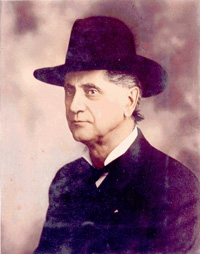Seventeen Years to Success:
John Muir, William Gladstone Steel, and the Creation of Yosemite and Crater Lake National Parks
By Stephen R. Mark, Historian, Crater Lake National Park
Introduction
 |
|
William Gladstone Steel |
Over the past century, activists have done much to stimulate legislative action for national parks and equivalent reserves. Their efforts have been a key factor in the National Park System’s continued expansion, particularly with respect to natural areas located in the western conterminous United States.(1) Great Basin National Park is the most recent example of this, having been established in Nevada during 1987.
In 1988, Hagerman Fossil Beds National Monument and City of Rocks National Reserve were established in Idaho. Like the Great Basin proposal, these units were created through the efforts of one activist.(2) This is hardly a new phenomena, because many of the oldest park units were the result of one-man efforts. Examples include Sequoia (1890), Crater Lake (1902) and Rocky Mountain (1915).
Campaigns for Sequoia and Rocky Mountain were comparatively short (seven years each), in contrast to the 17 years it took to obtain effective designation for Yosemite and Crater Lake. In comparing Muir’s campaign to place Yosemite Valley under national park administration with Steel’s effort to establish Crater Lake National Park, there are some broad similarities. Each man won deceptively easy battles soon after becoming an activist but found their larger goals more elusive. Besides framing their proposals similarly, they shared some methods still employed by modern park proponents. And like some of their modern counterparts, Muir and Steel were also able to adapt to changing political circumstances to finally achieve their aims.
John Muir (1838-1914) has become an international figure whose stature is related to the impact of his writings upon the conservation movement. After coming to California in 1868, he worked at various seasonal jobs in the Sierra Nevada before making a name for himself in the early 1870s as a writer. Although Muir mentioned national parks and preservation of forests in his early writings, he did not become an activist until 1889.(3)
The turning point came when Muir and an editor named Robert Underwood Johnson embarked upon a camping trip to Yosemite in 1889. On the second night of the trip, they sat in front of a campfire planning a campaign that would alter Muir’s life and the face of Yosemite. As Johnson later recalled:
It was at our campfire at the Tuolumne fall at the head of the canon that Muir let himself go in whimsical denunciation of the commissioners [appointed by the State of California to manage the state park in Yosemite Valley] who were doing so much to make ducks and drakes of the less rugged beauty of the Yosemite by ill-judged cutting and trimming of trees, arbitrary slashing of vistas, tolerating of pig-sties, and making room for hay-fields by cutting down laurels and under brush–the units by which the eye is enabled, in going from lower to higher and stir, higher trees, ultimately to get adequate grandeur of cliffs nearly three thousand feet high. It is an old scandal, and I only refer to it now because it was at this campfire that a practical beginning was made of a campaign which, after fifteen years, by the recent act of recession of the Valley to the United States, we may confidently hope has ended an era of ignorant mismanagement.(4)
Two superbly-timed magazine articles written by Muir for Johnson’s Century Magazine greatly aided passage of a bill creating a two million acre forest reservation. in the Yosemite region on October 1, 1890.(5) Yosemite Valley, however, remained under state control while the “forest reservation” became known as Yosemite National Park. Not until June 11, 1906, did Muir and Johnson realize the goal of getting the valley and surrounding national park under the unified administration of the federal government.
To frame his proposal, Muir had to summarize how he would address the problem of park management in Yosemite Valley. He did this by centering on three main points, the first being that the valley was explicitly a national, not state, concern. Muir believed the federal government had the ability to provide more permanent improvements and policies than did the state through its appointed commissioners. Federal control would lead to increased appropriations for roads, trails, and utilities which would facilitate greater tourist travel. The federal authorities would also be in an economically disinterested position. This would increase the chances that appropriate development would be coordinated by a landscape architect.(6)
The second part of Muir’s proposal was that resident authorities must have sufficient power to protect the entire park area. Galen Clark had been appointed guardian to the valley, but he had no assistants, little money for administration, and was under the orders of commissioners who were often motivated by political considerations. Muir preferred the use of the U.S. Army to guard Yosemite Valley and the backcountry from trespass by sheep, damage caused by careless campers, and the effects of forest fires. The latter was to prove especially troublesome under two jurisdictions because their representatives could not agree over who should pay for fire protection.

